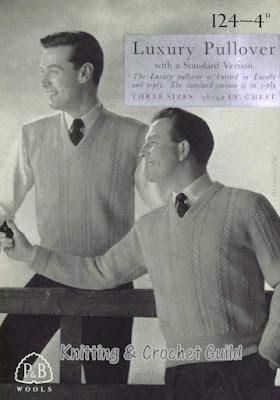Last week we were busy at Lee Mills having a big clear up (or Big Clear Up) - things that had been sorted once but not quite finished, things that had got into a bit of a mess,... Mostly I spent the week sorting out knitting needles (more later). And in a drawer that probably hasn't been opened for years, we found a long-forgotten cache of 1950s knitting wool.
It's Patons Lucelle Fine Ply, and as you can see I found some Lucelle pattern leaflets elsewhere in the Guild collection.
 |
Each ball has a ticket buried in the middle:
 |
It has three vertical panels of a lacy pattern on the front, but unfortunately the leaflet illustration doesn't show the lace clearly - you would have to knit a swatch to see what it looks like.
As the ticket with each ball says, Lucelle was a blend of wool, angora and nylon. It was intended as a luxury yarn, in imitation of cashmere. It seems to have been introduced in the early 1950s: I found an ad from November 1952, for "PATONS LUCELLE WOOL -- The New Cashmere Wool". It was priced at 2/6 per ball. 2/6 is directly equivalent to 12½p, so now that seems remarkably cheap, but the same ad gave the prices for 'Purple Heather Wool', 3-ply and 4-ply as 1/5 per ounce (7p) and 'Patons Super Fingering, 2-ply and 3-ply, as 2/- per ounce (10p). Since Lucelle was sold in ½ ounce balls, it cost 2½ times as much as Super Fingering, weight for weight.
Later Lucelle patterns, like Patons 114, were knitted to a looser tension, on 13s and/or 14s.
And even men were allowed the luxury of Lucelle: you could knit the pullover or long-sleeved sweater in Patons 124 below either in 3-ply or in one strand of 2-ply and one strand of Lucelle. The leaflet says "Lucelle and 2-ply knitted together make a fabric of the utmost affluence -- but there's also a down-to-earth version in 3-ply." (Though a hand-knitted long-sleeved sweater in 3-ply seems very luxurious to me, and not at all 'down-to-earth'.)
James Norbury, who was the chief designer for Patons throughout the 1950s, used Lucelle in The Penguin Knitting Book (published 1957) for two evening jumpers. Here's the nicer one.
 |
| Lady's Evening Jumper in Lucelle, from The Penguin Knitting Book, by James Norbury |
It has a chevron band around the low neckline, with a small cluster of pearls and sequins on each point - very elegant. I am sure that James Norbury had a team of knitters at his disposal, so he would have had no qualms about designing a jumper that requires a tension of 42 stitches and 52 rows to 4inches/10cm. on size 13 needles.
The latest Lucelle leaflets I have found so far are from 1960. Patons leaflet 1054 is for 'Two Lucelle Lovelies':
 |
 |



I too have just found some of this wool. It seems it almost belongs in a museum !! :)
ReplyDeleteHow lucky! I hope you will knit something with it - a little will go a long way.
Delete